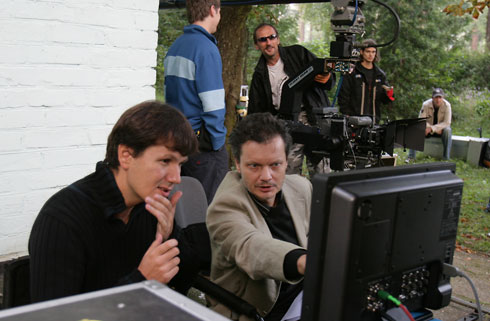Last of Pre-Production
 This week I started my final stages of Pre-production. I focused on the lighting, camera angles, artistic principles of design, and the look I want to convey with this piece. I decided to take a different approach to my sketchbook page and actually make it in my sketchbook. Above is a screenshot I captured from a youtube video interview and then took into Photoshop to point out how the different lights were affecting the subject. The right backlight adds light to the subjects left shoulder, neck and back of the head. The top light is at an angle so it lights up the back of the right shoulder, and the top of the hair, making a shadow with the bangs of the subject. The last light I think they used was a fill light that was low and pointed up from the viewers right side but the subjects left. I can tell because the face is softly illuminated which indicates a less harsh fill light. Also there is a shadow above the subjects left eye (reversed for viewer) that makes me believe the light is lower and pointed up.
This week I started my final stages of Pre-production. I focused on the lighting, camera angles, artistic principles of design, and the look I want to convey with this piece. I decided to take a different approach to my sketchbook page and actually make it in my sketchbook. Above is a screenshot I captured from a youtube video interview and then took into Photoshop to point out how the different lights were affecting the subject. The right backlight adds light to the subjects left shoulder, neck and back of the head. The top light is at an angle so it lights up the back of the right shoulder, and the top of the hair, making a shadow with the bangs of the subject. The last light I think they used was a fill light that was low and pointed up from the viewers right side but the subjects left. I can tell because the face is softly illuminated which indicates a less harsh fill light. Also there is a shadow above the subjects left eye (reversed for viewer) that makes me believe the light is lower and pointed up.
Below are my sketchbook pages in which I took the ideas I found throughout the week and combined them by drawing each camera set up and perspective out on a different page. Each page has three illustrations. 1, top left, is where the lights will be put based off of this specific camera angle as if I'm in the room and l am seeing the whole picture and not just what the camera sees. The second, bottom left, which shows a black box and inside is what I want the camera to actually capture, cropping out the set design and everything I don't want seen in the film. The third, bottom right, is of a birds eye view using symbols to represent the set camera, subject, lights, etc. each of these drawings is different because the camera that is being drawn and written about on each specific page is circled in blue pen accordingly. Along with the drawings I have written a few notes on the principle of design being used in the shot and other important things that translate to the illustrations. I am not quite sure about camera 3 yet. I was basing some of this from the knowledge off of what we learned last year with multicam editing. However, we did a two person conversation and the use of the right and left cameras were to get the same shot of the different subjects. But I am only using 1 subject and as I watch more interviews I am starting to realize that my 3rd camera angle should still be a zoomed out shot but maybe keep in on the right side with the rest of the camera to not disrupt the flow and switch up the views. I have not decided what I will do and this is probably the last decision I will make before actually filming my interview with Jack.








